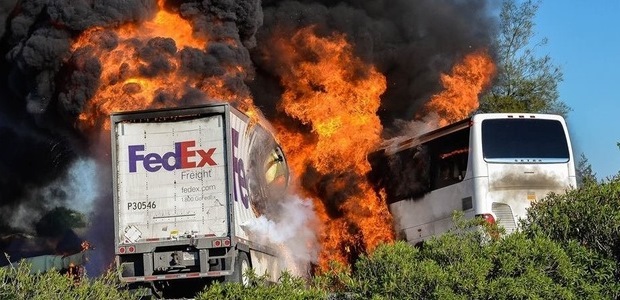
NTSB Calls for Motorcoach Safety Design Improvements
Its recommendations from the Orland, Calif., 2014 crash involving a tractor double trailer and a motorcoach also ask FMCSA to require all passenger coach operators to provide pretrip safety briefings and printed safety information to their passengers.
The National Transportation Safety Board on July 14 adopted a probable cause for the April 10, 2014, collision of a tractor double trailer with a motorcoach on Interstate 5 in Orland, Calif., an impact that resulted in 10 deaths and 39 injuries to passengers on the bus and in a passenger vehicle the truck struck after it crossed a 58-foot-wide median at about 5:40 p.m. The board found that the probable cause of the head-on collision was the truck driver's inability to maintain control of his vehicle "due to his unresponsiveness for reasons that could not be established from available information." Contributing to the severity of some bus passengers' injuries were high impact forces; the release of combustible fluids, leading to a fast-spreading post-crash fire; difficulties in motorcoach egress; and lack of restraint use, according to the board.
The board has recommended that motorcoach interiors be designed with improved flammability requirements and improved emergency exits, and that event data recorders be installed on commercial trucks and motorcoaches. Neither the truck nor the motorcoach in this crash were equipped with data recorders. "With access to event data recorders, we might have been able to determine why the truck crossed the median, which could have enabled us to make recommendations to prevent it from happening again," NTSB Chairman Christopher A. Hart said. "Much of the reason that aviation is so safe today is that we have required such recorders for decades so that we can learn the lessons of accidents. But they are still not required in commercial trucks or motorcoaches despite more than a decade of recommendations by the NTSB."
Both vehicles' drivers died in the accident. Investigators ruled out the drivers' experience, licensing, and training, alcohol or drug use, mechanical factors, and weather as causes of the crash, and they found no evidence that the driver was experiencing distraction, fatigue, or that he intentionally crossed into opposing traffic.
"The investigation brought to light the difficulty of getting out of a burning motorcoach," Hart said. "It is unacceptable for anyone who survives a crash to perish in a post-crash fire because the exits were too hard to find or too difficult to use." According to the agency, at least two passengers died because they could not exit the burning coach before succumbing to asphyxiation due to inhaling smoke from the fire.
NTSB said its investigation also revealed that the fire performance standard for commercial passenger vehicle interiors, Federal Motor Vehicle Safety Standard (FMVSS) 302, needs to be updated because flammability testing under it involves a small-scale fire source, such as those that might be caused by matches or cigarettes, which differs drastically from the actual common causes of bus fires.